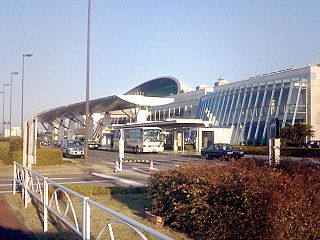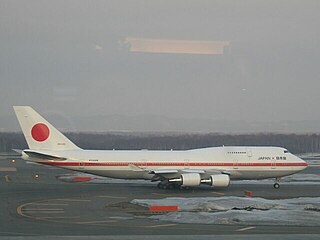
On July 23, 1999, an All Nippon Airways Boeing 747-481D with 503 passengers on Flight 61, including 14 children and 14 crew members on board, took off from Tokyo Haneda Airport in Ōta, Tokyo, Japan and was en route to New Chitose Airport in Chitose, Japan, near Sapporo when it was hijacked by Yūji Nishizawa.
All Nippon Airways Co., Ltd. is a Japanese airline headquartered in Minato, Tokyo. ANA operates services to both domestic and international destinations and is Japan's largest airline, ahead of its main rival flag carrier Japan Airlines. As of April 2023, the airline has approximately 12,800 employees. The airline joined as a Star Alliance member in October 1999.

The Boeing 747-400 is a large, long-range wide-body airliner produced by Boeing Commercial Airplanes, an advanced variant of the initial Boeing 747. The "Advanced Series 300" was announced at the September 1984 Farnborough Airshow, targeting a 10% cost reduction with more efficient engines and 1,000 nautical miles [nmi] of additional range. Northwest Airlines became the first customer with an order for 10 aircraft on October 22, 1985. The first 747-400 was rolled out on January 26, 1988, and made its maiden flight on April 29, 1988. Type certification was received on January 9, 1989, and it entered service with NWA on February 9, 1989.

Hakodate Airport is an airport located 7.6 km (4.7 mi) east of Hakodate Station in Hakodate, a city in Hokkaidō, Japan. It is owned by the Ministry of Land, Infrastructure, Transport and Tourism and operated by Hokkaido Airports.
This is a list of aviation-related events from 1977.

Air Nippon Network, or A-net, was an airline based on the grounds of Tokyo International Airport in Ōta, Tokyo, Japan.

Takamatsu Airport is an airport located 8 NM south southwest of Takamatsu, Kagawa, Japan. The airport primarily handles domestic flights, with a small number of international flights.

All Nippon Airways (ANA) Flight 58 was a Japanese domestic flight from Chitose Airport to Haneda Airport, operated by All Nippon Airways (ANA). On 30 July 1971, at 02:04 local time, a Japan Air Self-Defense Force (JASDF) F-86F Sabre jet fighter collided with the Boeing 727 airliner operating the flight, causing both aircraft to crash. All 162 people aboard the airliner were killed, while the Sabre pilot, a trainee with the JASDF, freed himself from his airplane after the collision and parachuted to safety. This incident led to the resignation of both the head of Japan's Defense Agency and the JASDF chief of staff.

Chitose Air Base, is a Japan Air Self-Defense Force base located in Chitose, Hokkaidō, adjacent to New Chitose Airport. It is the JASDF's primary base in northern Japan and tasked with monitoring Japan's maritime borders with Russia. It was also Hokkaidō's primary civilian airport until the opening of New Chitose Airport in 1988. Together, these two jointly operated and connected airports create one of the largest regional airports in Japan.

Hachijojima Airport is a regional airport serving Hachijōjima in the southern Izu Islands, Tokyo, Japan.

Yamagata Airport is an airport in Higashine, Yamagata Prefecture, Japan. The airport is 23 kilometres (14 mi) north of the city of Yamagata.

Japan Air Lines Flight 404 was a passenger flight which was hijacked by the Popular Front for the Liberation of Palestine and Japanese Red Army on 20 July 1973.

All Nippon Airways (ANA) Flight 60 was a Boeing 727-81 aircraft making a domestic commercial flight from Sapporo Chitose Airport to Tokyo Haneda International Airport. On February 4, 1966, all 133 people on board died when the plane mysteriously crashed into Tokyo Bay about 10.4 km from Haneda in clear weather conditions while on a night approach. The accident was the worst involving a single aircraft and was also the deadliest accident in Japan at that time until All Nippon Airways Flight 58 crashed 5 years later, killing 162.

On March 4, 1966, Canadian Pacific Air Lines Flight 402 (CP402) struck the approach lights and a seawall during a night landing attempt in poor visibility at Haneda Airport in Tokyo, Japan. Of the 62 passengers and 10 crew, only 8 passengers survived.

Haneda Airport, sometimes referred to as Tokyo-Haneda, is one of two international airports serving the Greater Tokyo Area, the other one being Narita International Airport (NRT). It serves as the primary base of Japan's two largest airlines, Japan Airlines and All Nippon Airways, as well as RegionalPlus Wings Corp., Skymark Airlines, and StarFlyer. It is located in Ōta, Tokyo, 15 kilometers (9.3 mi) south of Tokyo Station. The facility covers 1,522 hectares of land.

Narita International Airport, also known as Tokyo-Narita International Airport, formerly and originally known as New Tokyo International Airport, is one of two international airports serving the Greater Tokyo Area, the other one being Haneda Airport (HND). It is about 60 kilometers (37 mi) east of central Tokyo in Narita, Chiba. The facility since July 2019, covers 1,137 hectares of land and construction to expand to nearly 2,300 ha is under way.

Pokémon Jet refers to a number of aircraft operated by Japanese airline All Nippon Airways in a promotional Pokémon livery. The exteriors of the aircraft were painted with pictures of various Pokémon and the interiors were decorated with a Pokémon theme. Though the use of these liveries by ANA ended in 2016, the scheme has since been revived, this time with Solaseed Air in 2020, and Air Do and Skymark Airlines in 2021. In 2022, Scoot became the first non-Japanese airline to introduce a Pokémon Jet, followed by China Airlines and T'way Air later that year. In 2023, ANA resumed producing Pokémon Jet liveries for their aircraft after a 7 year absence.
Events in the year 1995 in Japan. It corresponds to Heisei 7 (平成7年) in the Japanese calendar.

British Airways Flight 2069 was a scheduled passenger flight operated by British Airways between Gatwick, England and Jomo Kenyatta Airport, Nairobi, Kenya. At 05:00 on 29 December 2000, a mentally ill passenger stormed the cockpit and attempted to hijack the aircraft. The 747 stalled in the struggle. Captain William Hagan and his crew were able to apprehend the assailant while first officer Phil Watson regained control of the aircraft, bringing the situation under control.
















